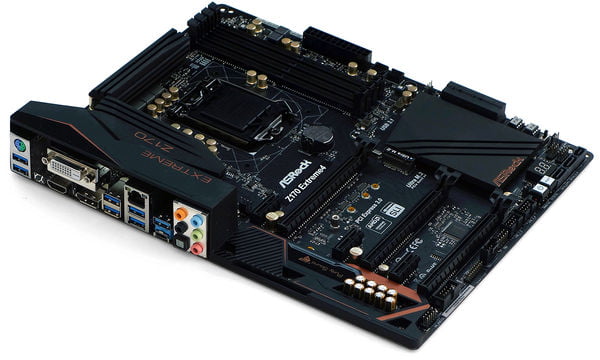

ASRock has already left a fairly solid impression on us after we tested its Z170 Extreme6, a board that was disqualified from award contention only because we couldn’t validate its beta firmware or pre-release accessories kit. That happens sometimes with pre-release product reviews, and ASRock did indeed change its accessories kit immediately after launch.
Today, ASROck gets another bite at the value-supremacy apple with its Z170 Extreme4, the next model down from the Extreme6. The Extreme4’s largest downgrade appears to be its loss of the add-in SATA controller in Extreme6. We’re even treated to the same I/O panel configuration, with its six USB 3.0 ports, two USB 3.1 ports, triple video outputs, full array of digital and analog audio connections, and handy CLR_CMOS button.
The loss of two SATA ports hardly seems worth the $25 to $34 price difference on a chipset that automatically supplies six, and that could be good news for value seekers as long as the cheaper model holds up in our stress tests.
Contents
Specifications
| Products |
| Pricing |
| Socket |
| Chipset |
| Form Factor |
| Video Ports |
| P/S 2 Ports |
| USB Ports |
| Network Jacks |
| Analog Audio |
| Digital Audio Out |
| Other Ports/Jacks |
| Bluetooth |
| PCIe 3.0 x16 |
| PCIe 3.0 x4 |
| PCIe 3.0 x1 |
| PCIe 2.0 x16 |
| PCIe 2.0 x4 |
| PCIe 2.0 x1 |
| CrossFire/SLI |
| SATA Ports |
| RAID |
| USB Headers |
| Fan Headers |
| SATA Controller/s |
| Wi-Fi Controller |
| USB Controller/s |
| LAN Chipset/s |
| Audio Codec |
| Voltage Regulator |
| Internal Buttons |
| Diagnostics Panel |
| Warranty |
 ASRock Z170 Extreme4 |
£108.46On Amazon |
| LGA 1151 |
| Z170 |
| ATX |
| DVI-D, HDMI, DisplayPort |
| 1 |
| 2 (3.1), 6 (3.0) |
| 1 |
| 5 |
| Optical, HDMI |
| TB Header, Serial COM Port |
| ✗ |
| 3 (x16/x8/x8, x8/x8/x4) |
| ✗ |
| 1 |
| ✗ |
| ✗ |
| ✗ |
| ✗ |
| 6 (6Gb/s) |
| 0, 1, 5, 10 |
| 1 (3.0), 1 (2.0) |
| 5 (4-pin) |
| ✗ |
| ✗ |
| ASM1142 PCIe (USB 3.1) |
| WGI219V PHY |
| ALC1150 |
| 12 Phases |
| Power, Reset |
| 2-Digit |
| 3 Years |
MORE: Best Motherboards
MORE: How To Choose A Motherboard
MORE: All Motherboard Content
Features
The Z170 Extreme4 is still laid-out to support three graphics cards with extra cooling space between the top card, or two cards with really thick coolers, with the two card option more-favored by the board’s x16/x0 to x8/x8 automatic switching. That third slot has only four lanes and shares bandwidth with everything else on the chipset (PCIe x1, networking, audio, storage) through an x4 connection to the CPU. Those who would rather configure the Z170 Extreme4 with extra single-slot graphics cards for low-bandwidth applications, such as wall-sized arrays of displays, will find that all three PCIe x1 slots are also open-ended, allowing the use of more-common PCIe x16 graphics cards.

The Z170 Extreme4 even has those same annoying single-sided DIMM latches that the Extreme6 features. Designed to ease memory replacement in boards with tight DIMM-to-graphics-card clearance, the Z170 Extreme4 doesn’t even make practical use of this feature, unless a builder chooses to put a super-long card in the uppermost PCIe x1 slot. As a memory tester, I’ve seen the sliding force contact “fingers” wear a single-latched slot out after a few dozen installations. Typical enthusiasts, if there ever was such a thing, should have little concern.
ASRock calls what looks like an 8+4 voltage regulator “10-phase.” Though that could mean 10+2 phase, I’ll call it 12-phase since so many of ASRock’s competitors quit advertising how their regulators are split. What’s apparent is that these use ASRock’s traditional chokes rather than the fancy ones of the Extreme6, but what’s not apparent is whether or not this will affect overclocking. ASRock rates the Extreme6’s chokes at 60A and traditional chokes at 20A, but their math still adds up to far more power than our Core i7-6700K needs to sustain a solid overclock.
ASRock added a switch for selecting between the two firmware ICs without advertising the feature, and even its manual shows three jumper pins there. Overclockers should enjoy the extra convenience of the switch and, should they somehow corrupt both ROMs, also enjoy that ASRock’s ROMs are socket-mounted.
The Extreme4’s onboard extras consist primarily of a power button, a reset button, and a two-digit status code display. We also find a Thunderbolt upgrade card header and a PCIe 3.0 x4 M.2 connector, both of which have become fairly common on mid-priced Z170 motherboards.
Layout is pleasing, with the “missing” expansion slot located under the upper PCIe x16 slot where it would likely be covered by a graphics cooler anyway, a USB 3.0 front-panel header located at the front edge above the uppermost slot, and an EPS12V power connector pushed far away from most bulky CPU coolers. Users with poorly-designed cases might have trouble getting their front-panel audio cables to reach the bottom-rear corner, but they should blame their case manufacturer for that.

The Z170 Extreme4 comes with four SATA cables and a single SLI bridge. Builders who install an M.2 drive should be completely satisfied with this cable assortment, since using the M.2 connector disables two of the six SATA ports.
[SOURCE:-tomshardware]
